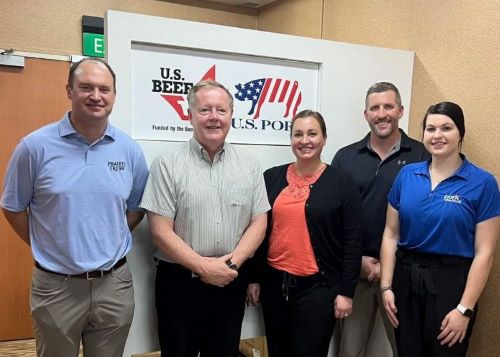U.S. Pork Trade Value: $61.26 Added to the Value of Each Hog Marketed

Despite what many called a challenging year for U.S. pork exports, at just over $7.6 billion, 2022 was a top-three year for pork export value. This equates to $61.26 added to the value of each hog marketed, explains Courtney Knupp, vice president of international market development for the National Pork Board.
Why is that important? Knupp says 27.5% of U.S. pork production went to international customers last year, adding over $60 to the value of the pig carcass.
“We're thrilled with those results, and we're excited to see where 2023 will take us,” Knupp says. “We have a very strong strategy to continue to diversify our markets, have strong presence in those markets on behalf of our producers and staff, and have a big goal to increase and enhance consumption in key regions like Central America and South America.”
Without international markets, today’s pork industry would look very different in the U.S., she adds.
“The international space in the U.S. pork industry provides huge value to our producers. The National Pork Board’s board of directors realizes that and continually funds international market promotion to best place U.S. pork.,” Knupp says.
A Strong Strategy to Grow Exports
An important part of the Pork Board’s international market strategy revolves around investment in a partnership with U.S. Meat Export Federation (USMEF), USDA and the National Pork Producers Council.
Market diversification and carcass utilization will continue to be two key areas of focus in 2023.
“We're continually targeting and assessing new markets. We see a lot of growing consumption and disposable incomes in regions like Central America. We also have great access there due to the implementation of our free trade agreements in the region,” Knupp says.
In March, Knupp and others will be a part of the U.S. delegation to go to Panama for a USDA ag trade mission. Not only will this allow them to meet directly with customers in the region, but the Pork Board is also conducting a complimentary analysis with one of its partners to best figure out how we go to market there, she says.
“That's a great example about how we're always trying to move the needle and establish relationships,” Knupp points out. “Once we’re in market, we’ll move from providing product to a further processing segment to then being able to brand and differentiate U.S. pork in the retail and food service sector, which continues to get more value for the product. We have our eye on that in all major markets, whether we see them as consistent partners, new partners, or ones that we can expand. We're very optimistic about the opportunities for U.S. pork now and in coming years.”
Chad Groves, senior vice president of sales, marketing and innovation for Seaboard Foods, says market diversification is crucial.
“What doesn’t show up in the numbers, unless you're close to it, is we've moved outside the traditional markets of China, Japan and South Korea. Those three markets have historically carried all of the weight for exports,” Groves says. “What makes me so proud about the industry is they've been working over the last few years to develop South and Central America. When those traditional markets were hit hard because of COVID, a strong dollar and other reasons, we were able to quickly pivot and shift product down into Central and South America and Mexico as well.”
He says that’s the power of USMEF, NPPC and the National Pork Board working together to keep profitability up and export markets open whether that’s going to the Eastern Hemisphere or staying in the Western Hemisphere.

Bob Ruth traveled with a group of producers and industry leaders in Panama learning about growth opportunities for U.S. pork.
The Power of the Producer
For Bob Ruth, National Pork Board board member and a Pennsylvania pork producer who recently retired from Clemens Food Group, participating on a trip to evaluate market conditions and opportunities in Panama and Colombia was one of the best decisions he’s made.
“The presence of a pork producer in the market where our customers are at is so very powerful,” Ruth says. “To be able to look that customer right in the eye and explain production practices and things that we do that are very important to those customers is so important.”
Some of those topics include sustainability and the high quality and safety of U.S. pork product, he notes. He also spent a lot of time sharing about the We Care principles U.S. pork producers abide by each and every day.
Animal welfare is prioritized differently around the world, and that’s why Ruth believes it’s absolutely important to engage about in conversation during these trips.
“It's something we're on the leading edge of, which makes us a little bit unique,” he says. “That really helps our marketing efforts. The We Care principles are something I credit the Pork Board for coming up with and our producers for embracing. I think it’s a great example of one of the areas that we show leadership in the marketplace.”
Ruth says he takes every opportunity he can to encourage producers to make sure they volunteer for upcoming trips because of that power they have sitting across the table from a customer.

(l to r) Chad Groves, Dermot Hayes, Courtney Knupp, David Newman and Kelli Wicks in Singapore learning about the marketplace.
A Rising Tide Lifts All Ships
Perhaps that’s why Groves is taking off time from his busy schedule to travel to Singapore and Thailand on a trip to learn more about opportunities for U.S pork export growth in these markets.
“This is an industry that's given so much to me and my family. By being on the board, by participating in these international trips, it allows me to give back to the industry,” says Groves who will be representing pork producers and packers. “A rising tide lifts all ships. We want consumers in each one of those markets to recognize the safety, quality and consistency of U.S. pork in the market.”
The two countries Groves will be visiting are very different in terms of how the U.S. does business in each and how the U.S. exports to each.
“Singapore historically has been open to U.S pork and is a Top 10 per capita consumption country. A lot of times in Southeast Asia, most producers and packers think of Japan, China and South Korea, the traditional powerhouses. But while Singapore has lower population than those countries, the high per capita consumption really makes up the gap and puts them in the top 10.”
When it comes to Thailand, Groves says the U.S. doesn’t have a free trade agreement in place. On the trip, their team plans to focus energy in Thailand working to better understand their needs and build relationships to set the foundation for future opportunities.
“I'm excited to build relationships within both countries and tell the story of the great production, both processes and product that we produce, to tell the story of how U.S pork can be differentiated in the marketplace,” Groves says.
Read More:
Chile: A Demanding Pork Export Market That Knows What It Needs







